Investigations on the Adhesive Contact Behaviors between a Viscoelastic Stamp and a Transferred Element in Microtransfer Printing
Abstract
1. Introduction
2. Model
3. Results and Discussion
3.1. Model Validation
3.2. Adhesive Contact Behaviors between a Polydimethylsiloxane Stamp and a Spherical Transferred Element
3.2.1. The Effect of Unloading Velocity
3.2.2. The Effect of Preload
3.2.3. The Effect of Thermodynamic Work of Adhesion
4. Conclusions
- There were good agreements between the finite element results with those for the elastic adhesive contact problem and the viscoelastic non-adhesive contact problem, thereby validating the description of the interfacial adhesion and the characterization of the viscoelastic property of the stamp in the present model, respectively;
- The force-approach curve during unloading did not coincide with that during loading due to the viscoelastic energy dissipation in the separation of the transferred element from the stamp. Furthermore, the unloading path deviated from each other for different unloading velocities and preloads;
- The pull-off force between the stamp and the transferred element can only be enlarged by increasing the unloading velocity in a certain range during the pickup process, while it can be diminished through decreasing the unloading velocity during the printing process;
- The pull-off force increased with the increasing preload, and the increasing ratio was higher under larger unloading velocity than that under smaller unloading velocity.
- Both the loading curve and the unloading curve were affected by the thermodynamic work of adhesion, and the larger the work of adhesion, the more noticeable the distinction between the loading and unloading curves. The pull-off force increased remarkably with the thermodynamic work of adhesion at fixed maximum approach.
Author Contributions
Funding
Institutional Review Board Statement
Informed Consent Statement
Data Availability Statement
Conflicts of Interest
References
- Zhou, H.; Qin, W.; Yu, Q.; Cheng, H.; Yu, X.; Wu, H. Transfer Printing and Its Applications in Flexible Electronic Devices. Nanomaterials 2019, 9, 283. [Google Scholar] [CrossRef]
- Meitl, M.A.; Zhu, Z.T.; Kumar, V.; Lee, K.J.; Feng, X.; Huang, Y.Y.; Adesida, I.; Nuzzo, R.G.; Rogers, J.A. Transfer Printing by Kinetic Control of Adhesion to an Elastomeric Stamp. Nat. Mater. 2006, 5, 33–38. [Google Scholar] [CrossRef]
- Neupane, S.; Rivas, N.A.; Losada-Pérez, P.; D’Haen, J.; Noei, H.; Keller, T.F.; Stierle, A.; Rudolph, M.; Terfort, A.; Bertran, O.; et al. A Model Study on Controlling Dealloying Corrosion Attack by Lateral Modification of Surfactant Inhibitors. NPJ Mater. Degrad. 2021, 5, 29. [Google Scholar] [CrossRef]
- Martinez-Rivas, A.; González-Quijano, G.; Proa-Coronado, S.; Séverac, C.; Dague, E. Methods of Micropatterning and Manipulation of Cells for Biomedical Applications. Micromachines 2017, 8, 347. [Google Scholar] [CrossRef] [PubMed]
- Chen, Y.; Lu, S.; Zhang, S.; Li, Y.; Qu, Z.; Chen, Y.; Lu, B.; Wang, X.; Feng, X. Skin-like Biosensor System via Electrochemical Channels for Noninvasive Blood Glucose Monitoring. Sci. Adv. 2017, 3, e1701629. [Google Scholar] [CrossRef] [PubMed]
- Peng, P.; Wu, K.; Lv, L.; Guo, C.F.; Wu, Z. One-Step Selective Adhesive Transfer Printing for Scalable Fabrication of Stretchable Electronics. Adv. Mater. Technol. 2018, 3, 1700264. [Google Scholar] [CrossRef]
- Jin, C.; Qiao, Q. Deformation of Pyramidal PDMS Stamps During Microcontact Printing. J. Appl. Mech. 2016, 83, 071011. [Google Scholar] [CrossRef]
- Xu, Y.; Xu, Z.D.; Guo, Y.Q.; Dong, Y.; Ge, T.; Xu, C. Tests and Modeling of Viscoelastic Damper Considering Microstructures and Displacement Amplitude Influence. J. Eng. Mech. 2019, 145, 04019108. [Google Scholar] [CrossRef]
- Yu, H.; Li, Z.; Jane Wang, Q. Viscoelastic-Adhesive Contact Modeling: Application to the Characterization of the Viscoelastic Behavior of Materials. Mech. Mater. 2013, 60, 55–65. [Google Scholar] [CrossRef]
- Carrillo, F.; Gupta, S.; Balooch, M.; Marshall, S.J.; Marshall, G.W.; Pruitt, L.; Puttlitz, C.M. Erratum: “Nanoindentation of Polydimethylsiloxane Elastomers: Effect of Crosslinking, Work of Adhesion, and Fluid Environment on Elastic Modulus. J. Mater. Res. 2006, 21, 535–537. [Google Scholar] [CrossRef][Green Version]
- Cheng, H.; Li, M.; Wu, J.; Carlson, A.; Kim, S.; Huang, Y.; Kang, Z.; Hwang, K.C.; Rogers, J.A. A Viscoelastic Model for the Rate Effect in Transfer Printing. J. Appl. Mech. 2013, 80, 041019. [Google Scholar] [CrossRef]
- Feng, X.; Cheng, H.; Bowen, A.M.; Carlson, A.W.; Nuzzo, R.G.; Rogers, J.A. A Finite-Deformation Mechanics Theory for Kinetically Controlled Transfer Printing. J. Appl. Mech. 2013, 80, 061023. [Google Scholar] [CrossRef]
- Liang, C.; Wang, F.; Huo, Z.; Shi, B.; Tian, Y.; Zhao, X.; Zhang, D. Pull-off Force Modeling and Experimental Study of PDMS Stamp Considering Preload in Micro Transfer Printing. Int. J. Solids Struct. 2020, 193–194, 134–140. [Google Scholar] [CrossRef]
- Sun, L.; Wang, L.; Rong, W.; Chen, L. Considering Van Der Waals Forces in Micromanipulation Design. In Proceedings of the 2007 International Conference on Mechatronics and Automation, Harbin, China, 5–8 August 2007; IEEE: Piscataway, NJ, USA, 2007; pp. 2507–2512. [Google Scholar]
- Hsia, K.J.; Huang, Y.; Menard, E.; Park, J.U.; Zhou, W.; Rogers, J.; Fulton, J.M. Collapse of Stamps for Soft Lithography Due to Interfacial Adhesion. Appl. Phys. Lett. 2005, 86, 154106. [Google Scholar] [CrossRef]
- Zhang, Y.; Wang, X.; Tu, Q.; Sun, J.; Ma, C. Mechanical Modeling and Characteristic Study for the Adhesive Contact of Elastic Layered Media. J. Phys. Appl. Phys. 2017, 50, 475601. [Google Scholar] [CrossRef]
- Derjaguin, V.B. Theorie des Anhaftens kleiner Teilchen. Prog. Surf. Sci. 1992, 40, 6–15. [Google Scholar] [CrossRef]
- Muller, V.M. On the Influence of Molecular Forces on the Deformation of an Elastic Sphere and Its Sticking to a Rigid Plane. J. Colloid Interface Sci. 1980, 77, 11. [Google Scholar] [CrossRef]
- Zhang, Y.; Si, L.; Zhang, X.; Li, J.; Wang, W. Investigations of the Adhesive Contact Behavior of Elastic Layered Media with Surface Roughness. J. Tribol. 2019, 141, 044504. [Google Scholar] [CrossRef]
- Kadin, Y.; Kligerman, Y.; Etsion, I. Loading–Unloading of an Elastic–Plastic Adhesive Spherical Microcontact. J. Colloid Interface Sci. 2008, 321, 242–250. [Google Scholar] [CrossRef] [PubMed]
- Song, Z.; Komvopoulos, K. Adhesion-Induced Instabilities in Elastic and Elastic–Plastic Contacts during Single and Repetitive Normal Loading. J. Mech. Phys. Solids 2011, 59, 884–897. [Google Scholar] [CrossRef]
- Wayne Chen, W.; Jane Wang, Q.; Huan, Z.; Luo, X. Semi-Analytical Viscoelastic Contact Modeling of Polymer-Based Materials. J. Tribol. 2011, 133, 041404. [Google Scholar] [CrossRef]
- Kim, K.S.; Lin, Z.; Shrotriya, P.; Sundararajan, S.; Zou, Q. Iterative Control Approach to High-Speed Force-Distance Curve Measurement Using AFM: Time-Dependent Response of PDMS Example. Ultramicroscopy 2008, 108, 911–920. [Google Scholar] [CrossRef] [PubMed]
- Lin, Y.-Y.; Hui, C.Y. Mechanics of Contact and Adhesion between Viscoelastic Spheres: An Analysis of Hysteresis during Loading and Unloading. J. Polym. Sci. B Polym. Phys. 2002, 40, 772–793. [Google Scholar] [CrossRef]
- Gai, P.; Xu, Z.D.; Guo, Y.; Dai, J. Gradient Chain Structure Model for Characterizing Frequency Dependence of Viscoelastic Materials. J. Eng. Mech. 2020, 146, 04020094. [Google Scholar] [CrossRef]
- Javan Nikkhah, S.; Moghbeli, M.R.; Hashemianzadeh, S.M. A Quantitative Correlation between Polyethylene/Graphene Interfacial Viscoelastic Dissipation and Deformation Parameters: A Molecular Simulation Study. Int. J. Adhes. Adhes. 2018, 84, 54–62. [Google Scholar] [CrossRef]
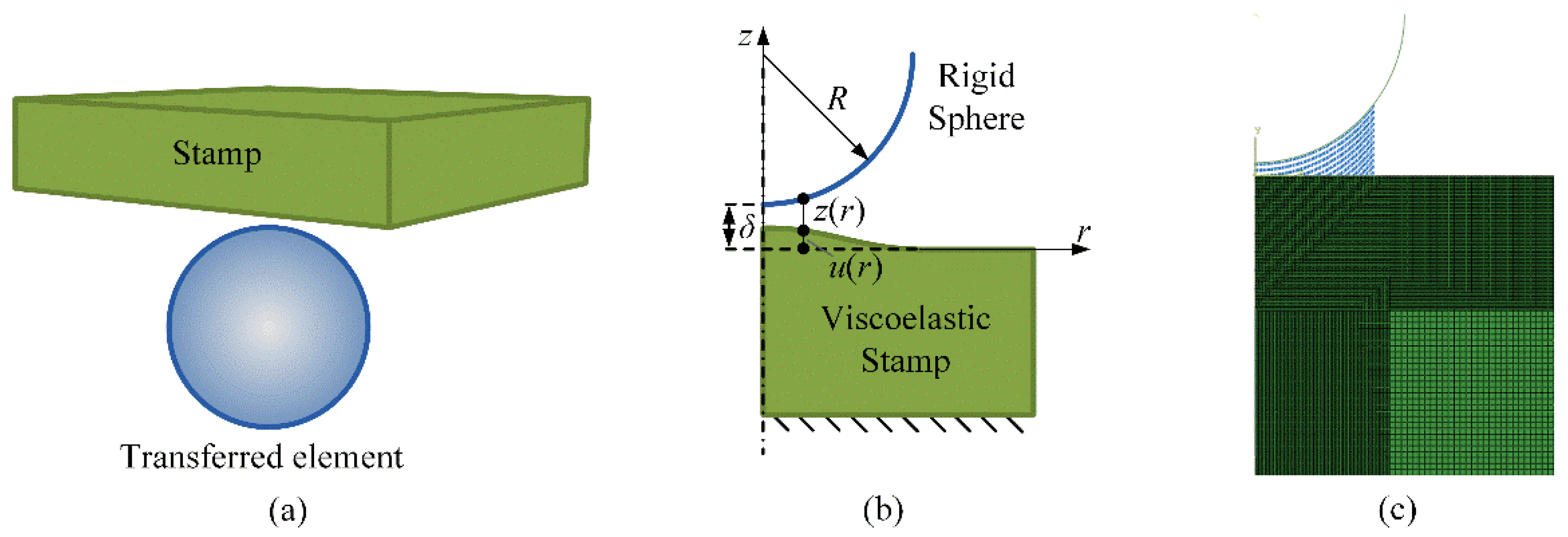

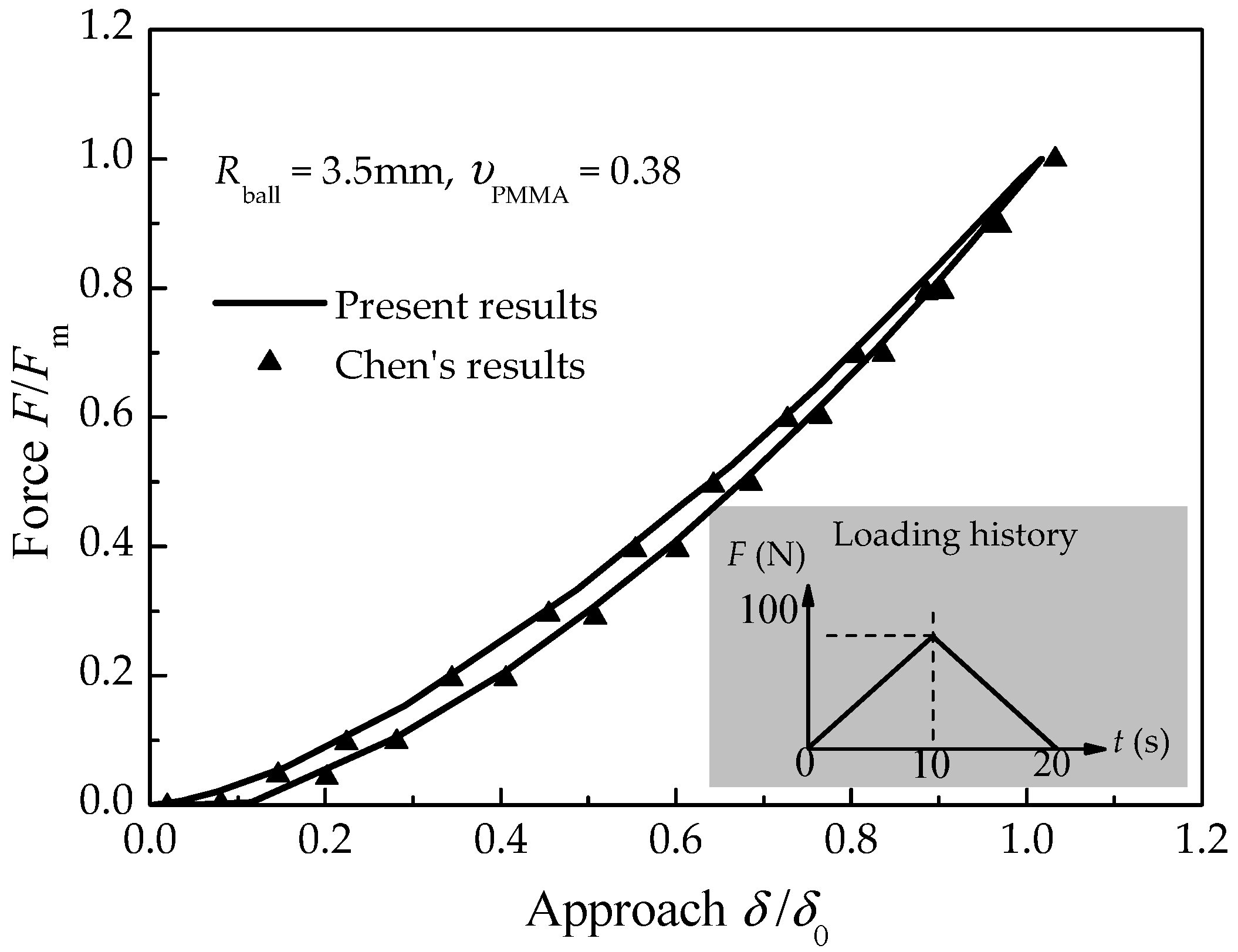
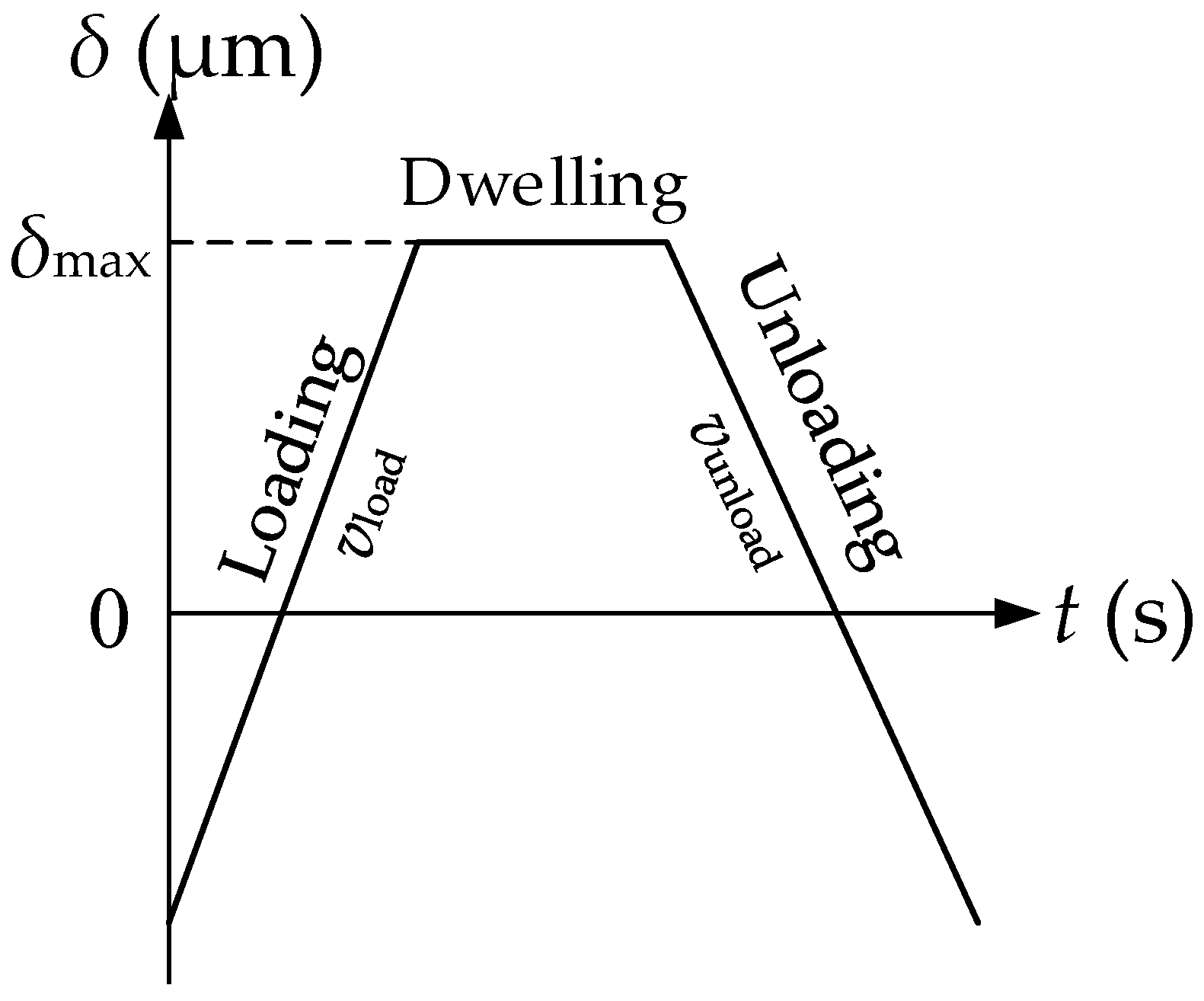
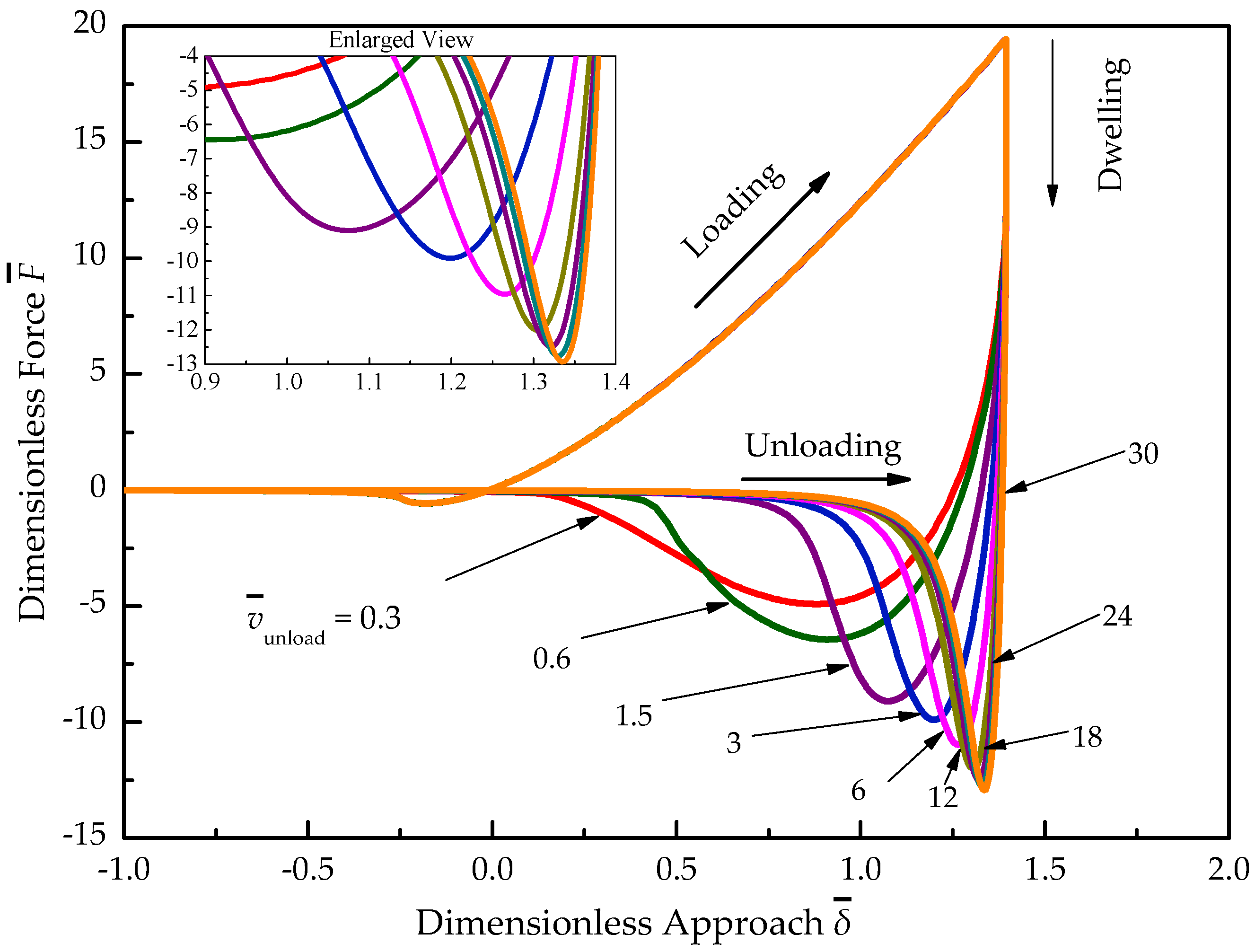
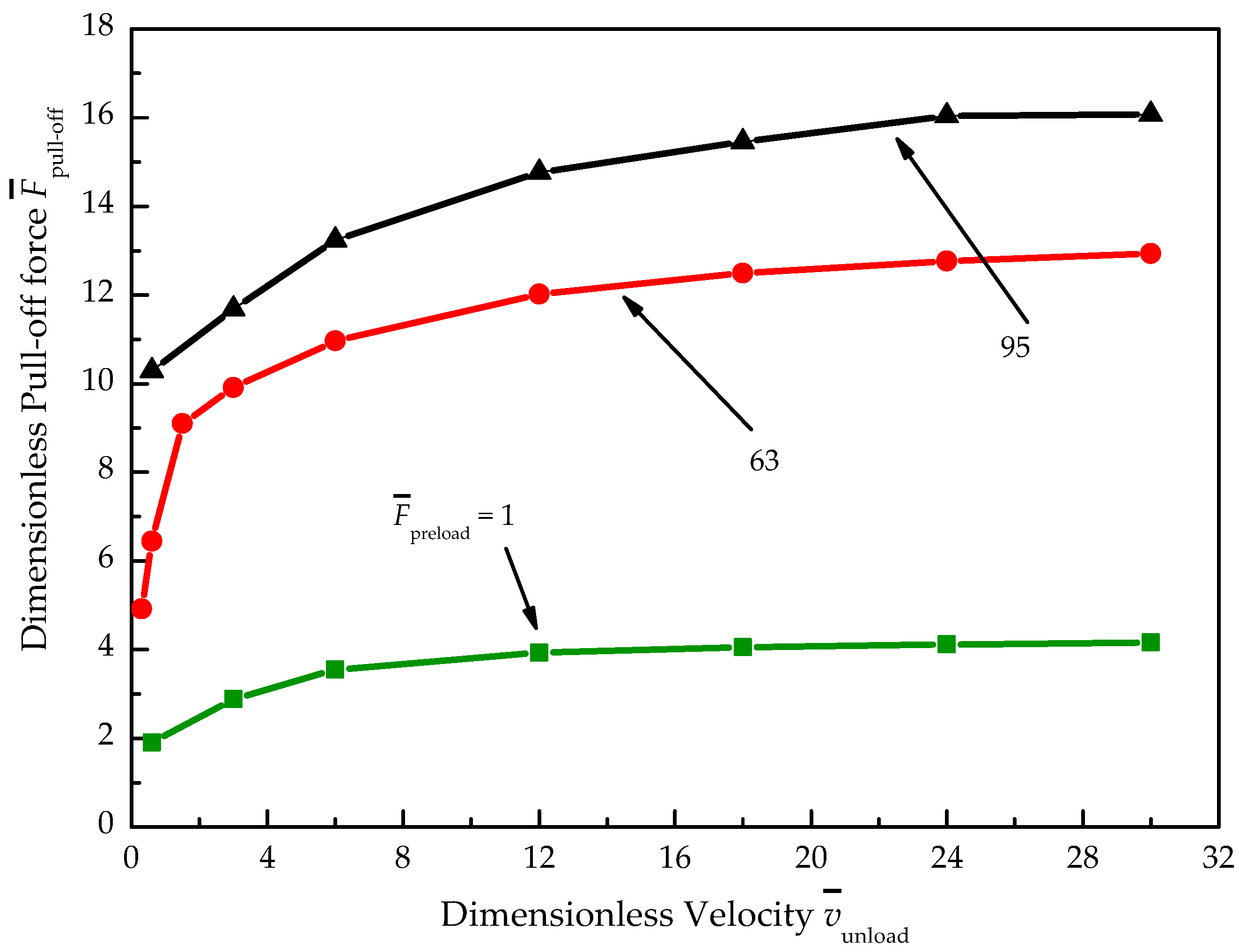
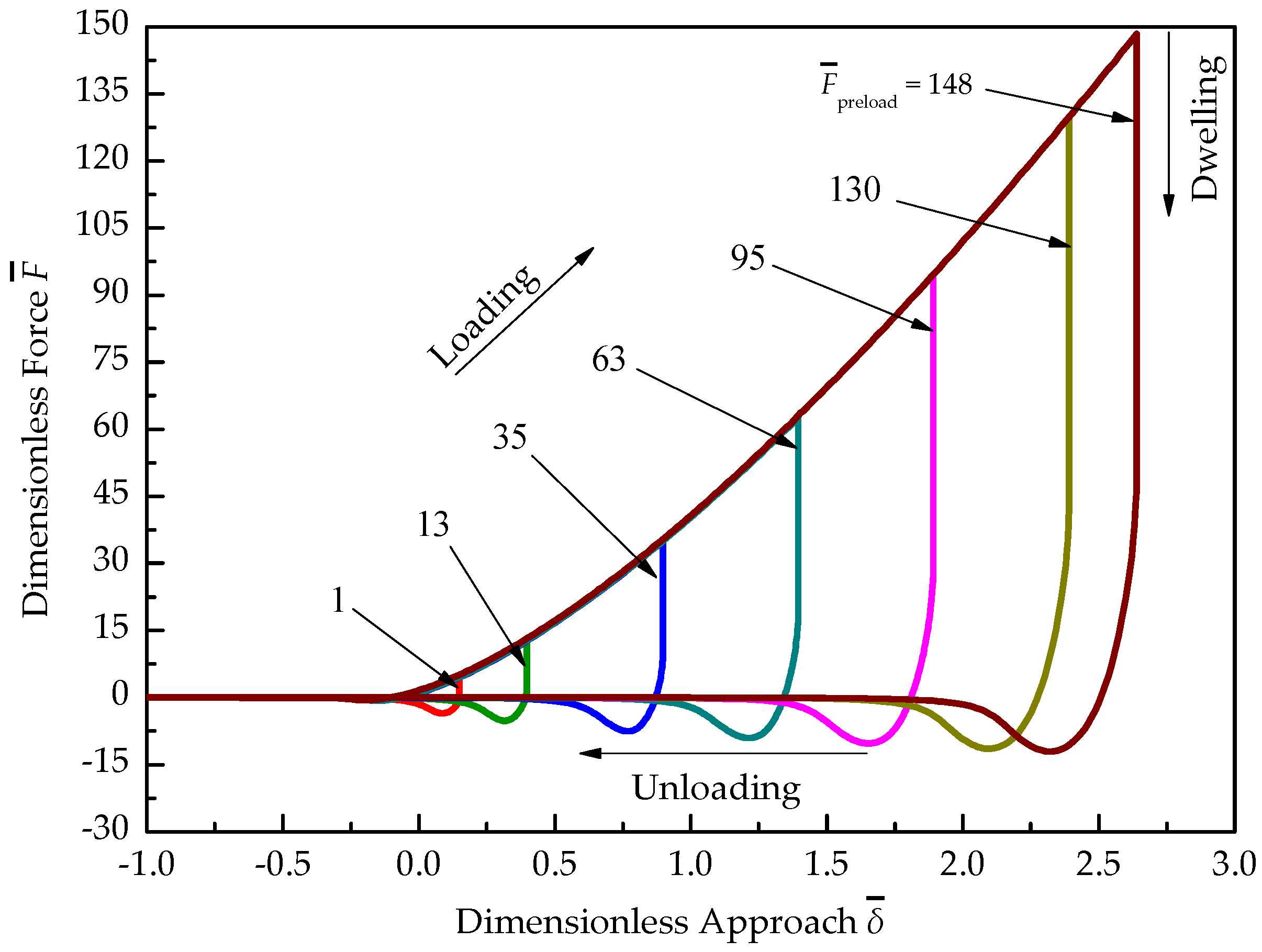
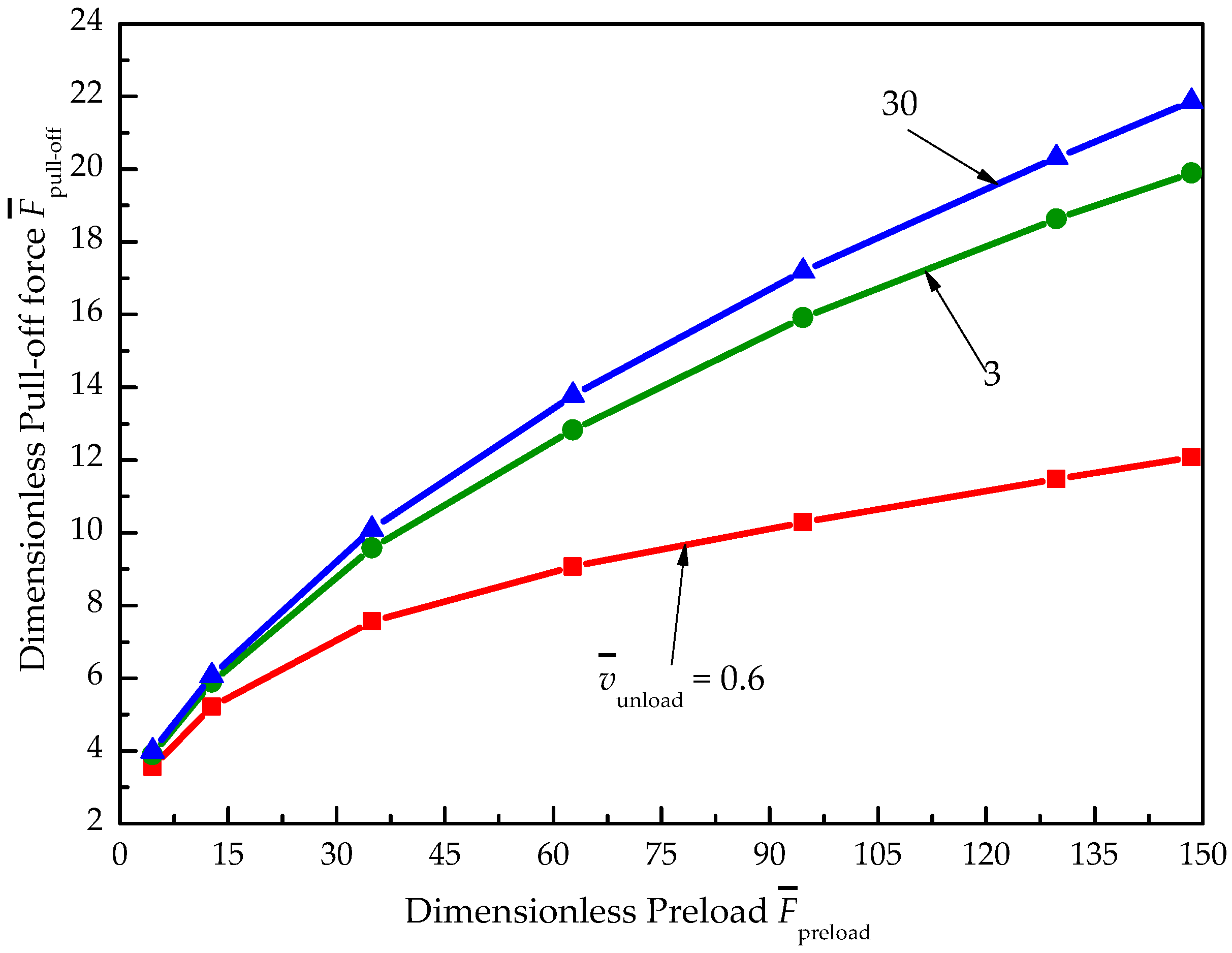

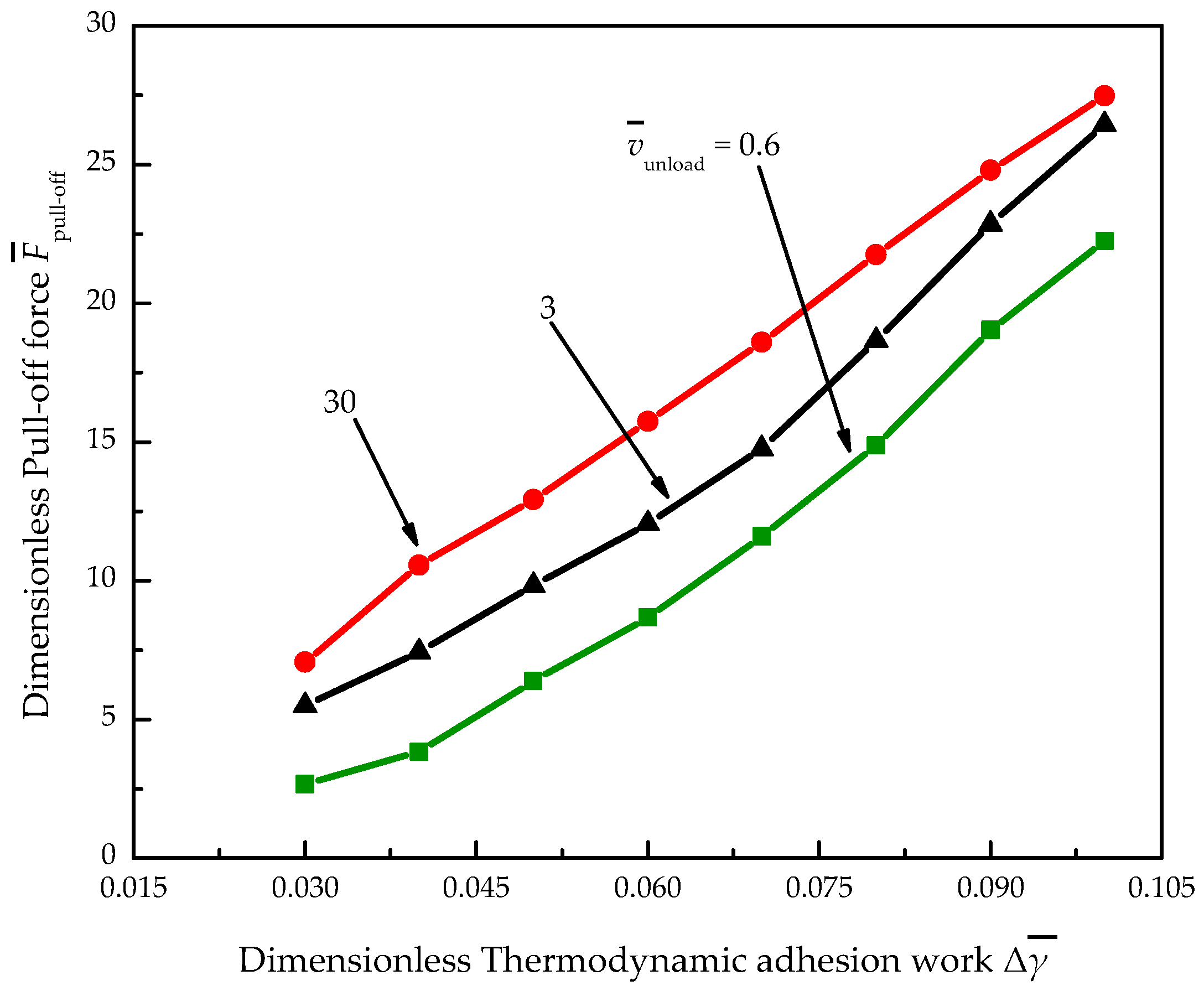
Publisher’s Note: MDPI stays neutral with regard to jurisdictional claims in published maps and institutional affiliations. |
© 2021 by the authors. Licensee MDPI, Basel, Switzerland. This article is an open access article distributed under the terms and conditions of the Creative Commons Attribution (CC BY) license (https://creativecommons.org/licenses/by/4.0/).
Share and Cite
Jiang, L.; Wu, M.; Yu, Q.; Shan, Y.; Zhang, Y. Investigations on the Adhesive Contact Behaviors between a Viscoelastic Stamp and a Transferred Element in Microtransfer Printing. Coatings 2021, 11, 1201. https://doi.org/10.3390/coatings11101201
Jiang L, Wu M, Yu Q, Shan Y, Zhang Y. Investigations on the Adhesive Contact Behaviors between a Viscoelastic Stamp and a Transferred Element in Microtransfer Printing. Coatings. 2021; 11(10):1201. https://doi.org/10.3390/coatings11101201
Chicago/Turabian StyleJiang, Ling, Mengjie Wu, Qiuping Yu, Yuxia Shan, and Yuyan Zhang. 2021. "Investigations on the Adhesive Contact Behaviors between a Viscoelastic Stamp and a Transferred Element in Microtransfer Printing" Coatings 11, no. 10: 1201. https://doi.org/10.3390/coatings11101201
APA StyleJiang, L., Wu, M., Yu, Q., Shan, Y., & Zhang, Y. (2021). Investigations on the Adhesive Contact Behaviors between a Viscoelastic Stamp and a Transferred Element in Microtransfer Printing. Coatings, 11(10), 1201. https://doi.org/10.3390/coatings11101201





